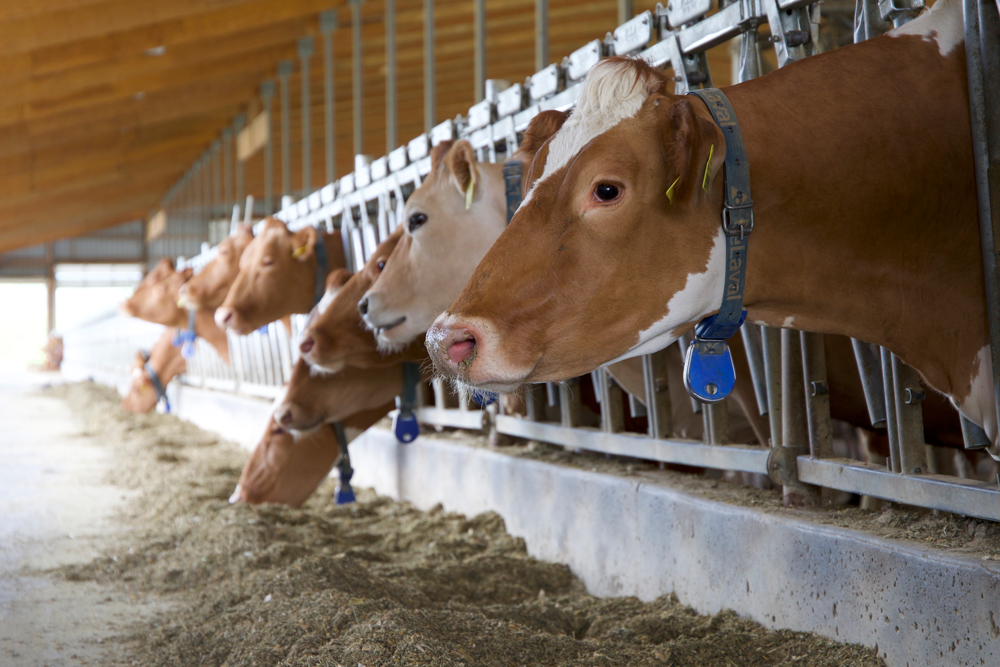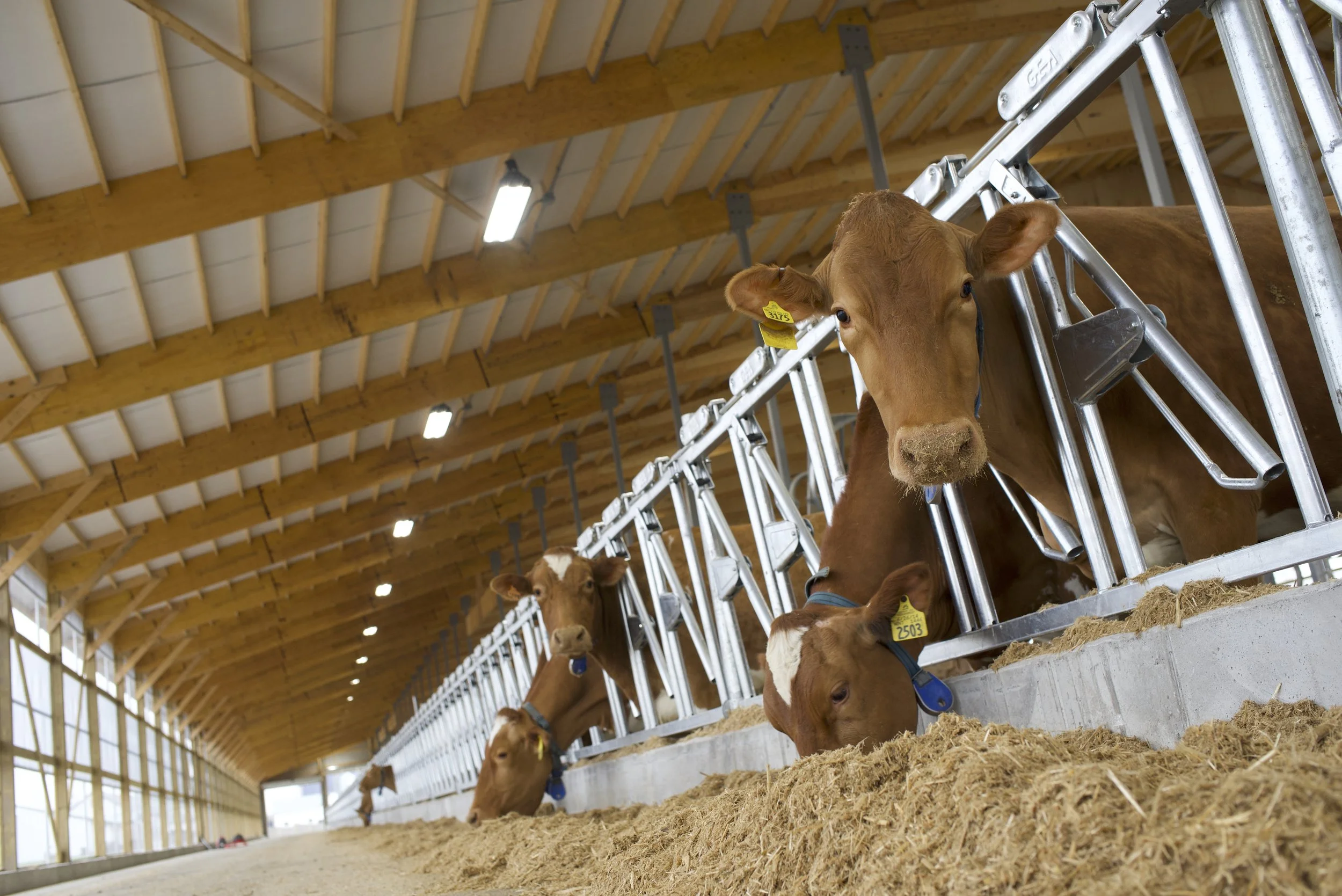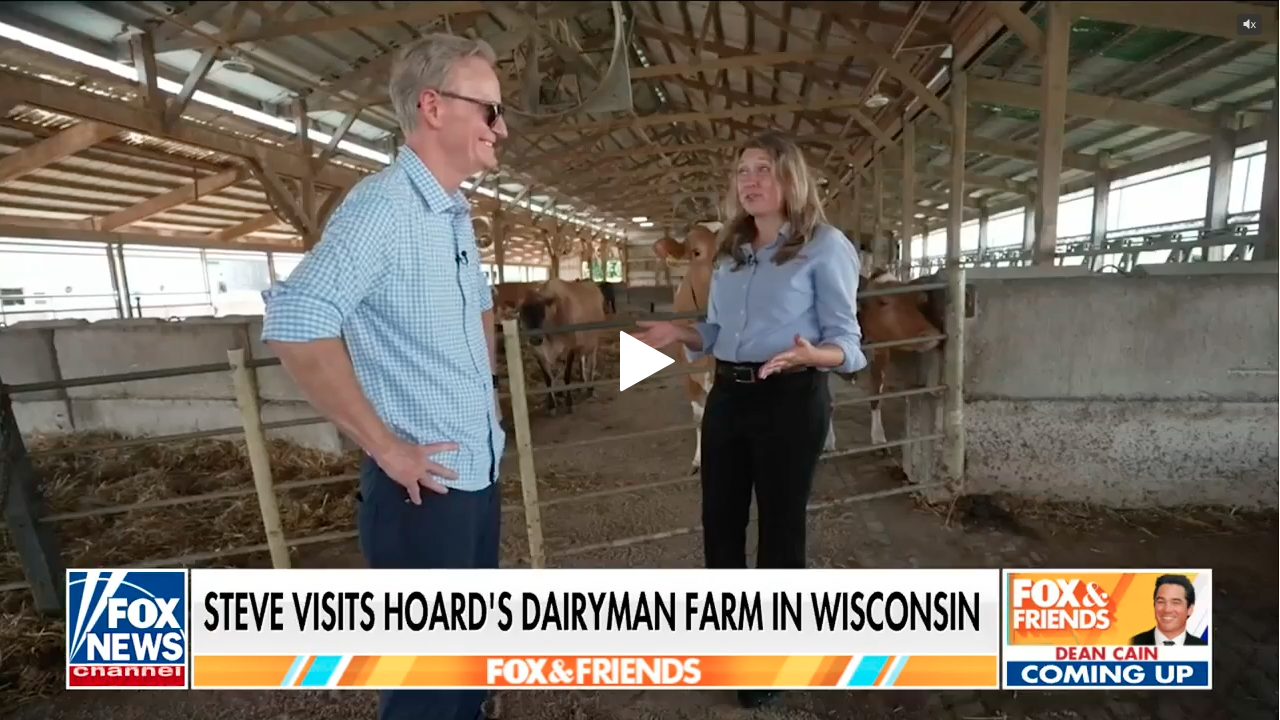Quiz time! Test your Guernsey cow knowledge, temperament edition
Guernsey cows have a generally _____ temperament.
a. Volatile
b. Aggressive
c. Mild
d. Irritable
Scroll past the photo to get the answer!
Guernsey cows at the Hoard's Dairyman farm
If you guessed C. Mild, you’re right! Guernsey cows generally have a mild temperament.
Cheddar nuggets galore
County fairs spotlight dairy farmers and Wisconsin cheese.
Cheddar nuggets with ranch.
Summer is for county fairs. Draft horse shows, carnival rides, magic shows, fresh squeezed lemonade, log rolling — the enormous week-long gatherings represent what it is to let loose in the United States: terrible fun, fried food, and exorbitantly priced, winner-never games.
If you don’t go to the fair, you’re likely missing out on a quintessential American right of passage. For Midwest folks, you’re also forfeiting a chance to experience cheese curds at their finest.
Hot, stringy, melt-in-your-mouth…fried county fair Wisconsin cheese curds are about as iconic as they come. Just ask Belvidere, Illinois’, 2024 Boone County Fair attendees. Some of the most populous lines across the grounds were those for vendors advertising “Wisconsin cheese.”
Dairy barn at the Boone County Fair
A (purely educational) taste test of my own halfway through a day-long fair excursion confirmed that the acclaimed “cheddar nuggets” were, in fact, an experiment in perfection. If their chewy plumpness and savory center weren’t enough, the crisp edge of their exterior sealed the tastebud deal. Among my party, they were the night’s clear winner.
But dairy at the fair is not limited to decadence. A quick jaunt down the dirt road from where our senses took root lay the designated dairy barn, where attendees could walk past stall after stall of beautifully groomed dairy cows.
“They get bathed and blown out before their showing,” said 4-H alumni Becky Schroll. “The best cow gets an award.”
“Best” can mean a set of criteria ranging from rump and hooves to legs and udders. A judge examines each entry and determines which meets these requirements with the most precision. The shows aren’t just for awards, either.
“Local companies support 4-H members by purchasing shown livestock at an auction,” Schroll said.
In the barn, each and every farmer’s face told the story of dedicated agricultural labor. Exhausted family members napped beside their stalls in touching solidarity with the animals they care for.
It’s easy, I realized, to forget about the people who make possible our daily nutritional servings. Basket of cheese curds in hand, stunning heifers on either side of the path ahead, I paused to take it all in. I thought about how lucky we all were to bear witness to the great service that is dairy farming.
Hoard’s Dairyman Farm Creamery cheeses may not come battered and fried, but they can be made to be so. Peruse our selection and decide on your own unique path into the world of quality dairy products.
Quiz time! Time to test your Guernsey cow knowledge.
Q: Guernseys weigh about ______ pounds at maturity.
A. 800 - 1,000
B. 1,200 - 1,300
C. 1,800 - 2,000
D. 500 - 700
Scroll past the image for the answer!
If you guessed B. 1,200 to 1,300 pounds, you would be right! Guernsey cows are large animals, but they’re not the largest dairy cow breed.
Our farm gets a shout-out
On July 16, Fox News profiled the Hoard’s Dairyman Farm in a prolific ode to farmers everywhere.
In a recent Fox News segment, reporter Steve Doocy visited the Hoard’s Dairyman Farm in Fort Atkinson, Wis., to learn more about America’s Dairyland and show appreciation for modern-day farming.
During the tour, he interviewed Hoard’s Dairyman editor Abby Bauer, W.D. Hoard and Sons Co. president and owner Brian Knox, and Hoard’s Dairyman Farm manager Jason Yurs.
The farm was established in 1899 by W.D. Hoard, who had started the Jefferson County Union and then Hoard’s Dairyman magazine years earlier.
“Hoard was the father of the entire American dairy industry,” Knox said. And that industry is shrinking — fast.
“Today, there are just around 26,000 dairy farms across the U.S.,” said Bauer. “Thirty years ago, there were about 125,000.”
Most of those 26,000 farms have been in the same family for generations, Bauer continued. But as costs of necessities from machinery to fertilizer rise with no sign of coming down, staying afloat is increasingly difficult.
“A tractor that cost $400 when I was growing up now costs $170,000,” Doocy said.
This was Hoard’s mission then, and it is Hoard’s Dairyman’s mission still: to be a voice for dairy farmers, to champion them in their profession, and to make possible the continued progression of the industry.
“We’re trying to help the modern-day farmer learn about new technology that’s available, new research that’s being done, and anything that can help them be more profitable,” Bauer said.
Doocy paid a visit to the robotic milking parlor and the freestall barn, among other notable farm localities.
While standing in front of a row of stunning Guernseys, Doocy said, “It’s so easy to grab a gallon of milk out of the cold case at the grocery store, but it’s a long journey to get it there.”
Ancestry — Herds’ Version
Cows are not indigenous to the Western Hemisphere. So where did they come from? Studies show that cattle were brought to the New World as early as the 15th century.
Cows were as early a settler to our land as the pilgrims. According to the essay “The Introduction of Cattle Into Colonial North America” by G.A. Bowling, Christopher Columbus’ second voyage in 1493 included a shipment of cattle, which would be the first domestic livestock to inhabit the “New World.”
From there, a combination of these cattle — plus French, Dutch, and African breeds, introduced to regions spanning from the Caribbean to modern-day California — merged to become the cattle raised across North and South America today.
The animals were primarily used for work, rather than meat and dairy production, although milk did become a staple for both adults and children around the early 17th century, right around the time mass cattle imports slowed.
Three centuries later, Americans took on a new cow-venture: providing the occasion for the arrival of Antarctica’s first domesticated bovine guest. Richard E. Byrd led an expedition to the continent with three sponsored cows (and one unborn calf).
With the increasingly specific research that is being done on herd histories, it’s entirely possible we have yet only scratched the surface of cattle’s origin stories. However, given the knowledge we do have, it’s safe to say the dairy you consume today can be traced back to beasts of old — beasts of a time when milk meant staving off starvation and drawn plows meant soil for the season’s harvest. When hand and hoof meant the beginning of a now flourishing industry.
Learn more about your herd’s ancestry on the Journal of Dairy Science’s website, and shop our selection of historic Hoard’s Dairyman Farm Creamery cheeses at www.hoardscreamery.com.
Will bike for cheese!
The largest road cycling series in the U.S. featured Hoard’s Dairyman Farm Creamery cheese as its winning prize.
Our Creamery Director, Ricardo, presents the winners with their prize: Hoard’s Dairyman Farm Creamery cheese.
From June 13 to June 23, Wisconsin’s 15th annual Kwik Trip Tour of America’s Dairyland led cyclists across the southeastern part of the state on a quest for victory — an honor that this year included wheels of Hoard’s Dairyman Farm Creamery Belaire cheese.
Bill Koch — one of the event’s founders — said the tour is a way to bring communities together and celebrate the state’s deep dairy identity.
Professionals, amateurs, and kid cyclists alike sign up to join a variety of races put on every day for eleven days.
Courses range from a half-mile to a full mile. Competitors race the course for up to 75 minutes and receive points based on their finishing order in each race they compete in. Overall winners are determined based on points earned by racing various series ranging from five to eleven days.
“Our average rider races five to six days,” Koch said. “So, it’s a whole smattering of combinations of race days for the various athletes that do it.”
A sporting event as well as a community block party that celebrates America’s Dairyland, the tour attracts competitors from far and wide. This year, the pool of athletes represented 41 states and 14 countries.
Ricardo with Alice in Dairyland
Our own Ricardo Gutierrez attended the event as a Hoard’s Dairyman Farm Creamery representative. He handed winners the symbolic Hoard’s Dairyman Farm Creamery wheel on the podium. It was empty. They get the cheese later, because no one wants to hold both a race trophy and a five-pound cheese wheel above their head minutes after racing! He also worked with Koch and other officials to promote Wisconsin dairy by including wedges of Hoard’s’ Cheddar in event-day swag handouts.
Check out the official Tour of America’s Dairyland website to learn more, and visit www.hoardscreamery.com to order your own variety of Hoard’s Dairyman Farm Creamery cheese.
Dairy’s new era
A cutting-edge research facility broke ground this summer in Wisconsin.
NPR’s Wisconsin Public Radio recently published an article about the construction of a new dairying research facility in Prairie du sac, Wisc.
The facility, funded by a partnership between The U.S. Department of Agriculture (USDA) and University of Wisconsin-Madison’s College of Agriculture and Life Sciences (CALS), is intended to “tackle key issues affecting dairy farms across the country.”
Some of what the researchers will be looking into includes robotic milking equipment, manure-borne pathogen prevention, improving soil health, and other holistic studies of modern dairy farming practices.
There are two kinds of robotic milking systems: free flow and guided flow. In a free flow system, cows can approach the robots at any time to see if they are eligible to be milked. In a guided flow system, a series of gates direct cows to the robots or the feedbunk. Researchers will look into what the benefits are of both, as well as how to make milking and cow care more efficient in this era of labor shortages.
Experts involved with the construction of the new research facility hope it will help bring about “resiliency in the face of climate change” for farmers across the nation.
At the Hoard’s Dairyman Farm, we already implement many of these technologies. In fact, the farm was showcased in the NPR report as a dairy already on the cutting edge of the technological revolution in agriculture. Our top-notch milking systems bring pure Guernsey milk from cow to consumer – and make possible the crafting of our award-winning cheese.
The dairy research facility is scheduled to be completed in 2027.
Quiz time! Test your Guernsey cow knowledge.
The two breeds Guernseys are thought to have come from are _______ (nationality).
A) French
B) English
C) Irish
D) Portuguese
(Scroll past the photo to see the answer!)
Guernsey cow calf
Answer: If you guessed A) French, you’re right! The two breeds of Guernseys are thought to have originated in France.
Here comes the brie!
Cheese cake tiers offer a savory spin on the traditional wedding dessert.
A slice of brie.
Wedding season is upon us, and so is cake eating. But what if you’re gluten-free? Or sugar-free? Or not a fan of cake in general (suspiciously. . .)? Or what if you simply want to change things up? What if (last one) you love cheese?At a wedding I attended recently, the bride and groom offered a cheese cake (not to be mistaken for a cheesecake) as a dessert option. They still had the traditional cake-cake (to avoid an uproar from sweet-toothed attendees, perhaps), but as an ode to their Wisconsin roots and love for the dairy food group, they also served a four-tier “cake” of cheddar, gouda, blue, and brie cheeses. How creative, I thought, and how brilliant — I spent more time at the cheese and fruit table than on the dance floor. What can’t dairy do?Turns out the couple had composed their “cake” from a personal selection of local wheels, but a quick browse of cheesemakers’ websites from around the world reveals offerings of le gâteau du fromage in a variety of compilations. The Dairy Farmers of Wisconsin, New York City’s Murray’s, and the UK’s The Fine Cheese Co. and The Courtyard Dairy are just a small sampling of places that offer artisan cheese cakes. The towers include a carefully curated variety of artisanal cheeses from each specified cheesemaker. Usually, the cake is some combination of a soft cheese, a hard cheese, an aged cheese, and a mixed-milk cheese, or something of the like. The tiers are shipped to the buyer as separate pieces and can be assembled or decorated as desired with flowers, fruit, or other adornments.Cheese cakes are not limited to weddings, of course. A curated tower could easily grace the menu of any event or gathering — small or large. Why not try for a savory dessert course next time you reach for the host or hostess cap? Or, if you aren’t feeling the wheel, visit www.hoardscreamery.com to peruse Hoard’s Dairyman Farm Creamery’s portioned cheese selection. Launch the cheese!
A small town in Sicily takes its romano to the streets.
Novara di Sicilia, Italy
Turns out, Gloucestershire, England’s Cooper’s Hill cheese rolling race isn’t alone in its curation of cheese-related athletic events. The Lancio del Maiorchino in Novara di Sicilia, Italy, is an extravaganza all its own.TraditionalSports.org published a breakdown of the game, detailing its tournament-length competition that takes place during the four weekends leading up to a “Maiorchino Festival.”Using a shoemaker’s twine three meters in length called a “lazzada,” team members launch a wheel of local pecorino romano cheese along a historic route through the city streets, from “via Duomo to via Bellini” (the word “via” precedes street names in Italy), and ending at the “Don Michele” rock wall. The team that completes the course with the least number of throws wins the race. The month-long competition then culminates at the Maiorchino Festival, where the overall victor takes home a wheel of Maiorchino cheese, and community members partake in a town-wide tasting of local products. This tradition derives from the early 1600s, a time when cheesemakers rolled cheese wheels through the streets to control their maturing. According to Neal’s Yard Dairy, the practice of “rolling” cheese wheels — now referred to as “turning” — is meant to prevent the build-up of moisture. The Maiorchino pecorino wheels used in the competition have been aged for eight months and weigh between 10 to 18 kilograms, or 22 to 39 pounds. Unfortunately, due to the cheese’s complicated production technique and growing sanitary regulations for food production, the specialty Maiorchino cheese is increasingly difficult to source. Check out this reel for a closer look at the game, and satiate your own lancio del hunger with Hoard’s Dairyman Farm Creamery’s selection of cheeses made from our pure Guernsey milk. 














